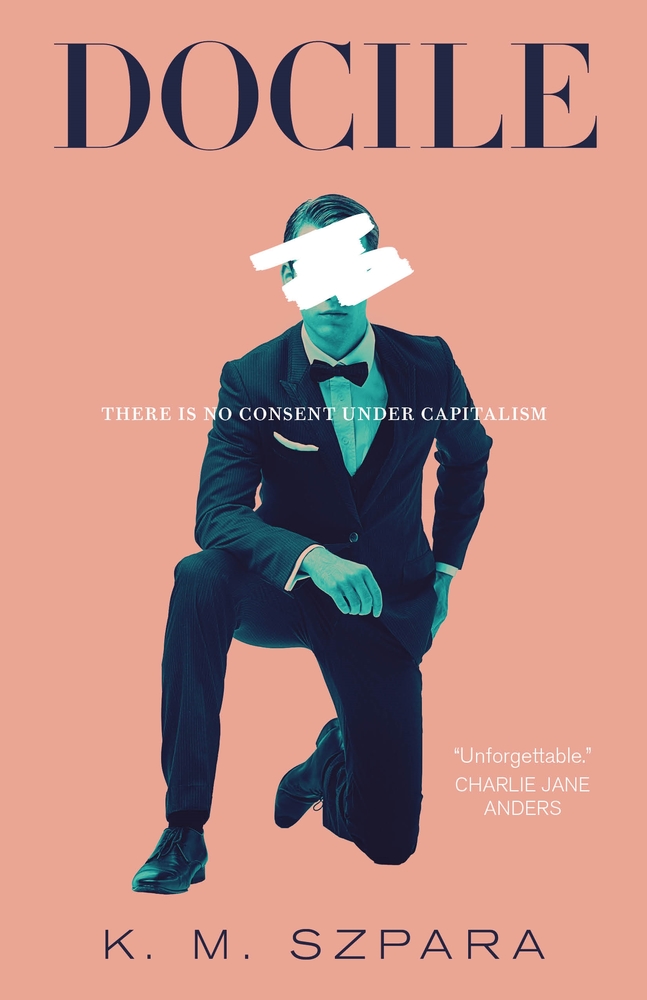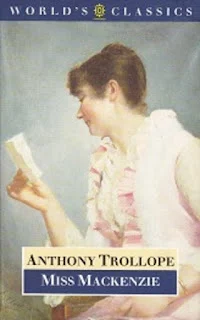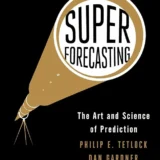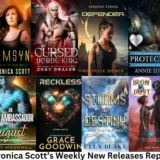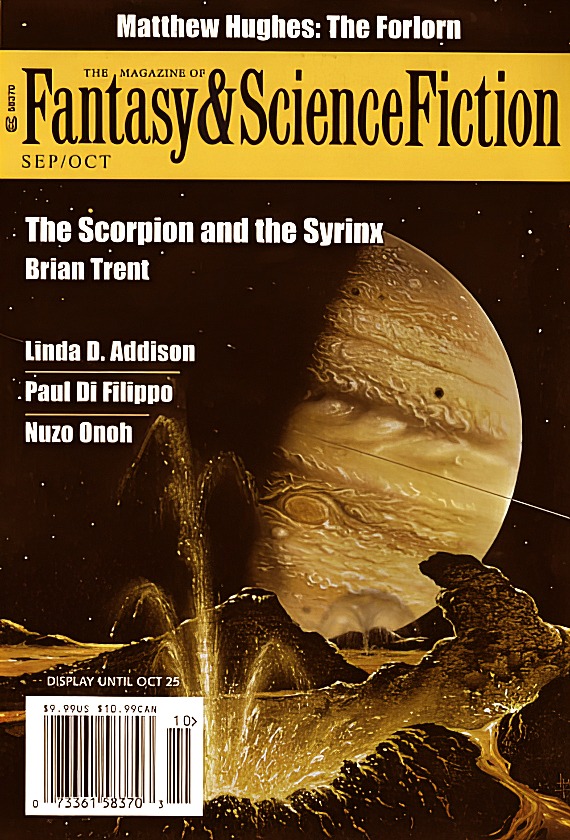
Well, heck. Summer seems to be over; pumpkins are ripening; people are buying enormous amounts of candy; and the Sept./Oct. issue of F&SF is out (it’s nearly time for the next one!). Figure 1 shows the cover—by David A. Hardy, a beautiful astronomical of Jupiter seen from Io. He’s one of the better long-term F&SF cover artists, along with Chesley Bonestell, Ed “EMSH” Emshwiller, Kelly Freas, and Mel Hunter. Oh, there are many more artists who’ve done multiple covers, but those five seem to be my favourites. And the inside is exciting, too.
I think this time I’ll go through it in the order the stories are shown in the published issue. (I get only the fiction as a “review copy,” but I also subscribe to the printed F&SF, even though it’s more expensive in Canada.)
This time I think I’ll take all the fiction in order of appearance in the printed issue’s TOC (Table of Contents). I should also note that besides the fiction and poetry, there’s an editorial by Sheree Renée Thomas; book columns by Charles de Lint and Elizabeth Hand; a column by Paul di Filippo called “Plumage from Pegasus: Speaker to Scribes”; a film column by Karin Lowachee; a science column by Jerry Oltion; and a “Curiosities” column by Aurelius Raines II. And cartoons by Ali Solomon, Arthur Masear, Mark Heath, and Kendra Allenby. A packed issue indeed!
First up is a novella by Nuzo Onoh, titled “The Abomination” (which was originally titled “IHAA” in the Igbo language; Onoh is a Nigerian-born British writer). IHAA lives with the mad widow Golu, his/her adoptive mother; shunned as an abomination, he/she has both male and female genitals and was scheduled to be decapitated, until the widow took her in place of her dead husband and children. Because of the blood curse that struck the widow Golu, nobody wanted to fight her. Now, years later, Ihaa lives a life of shame because of his/her own curse of abomination. From here it develops into a story of wrongs avenged… with more wrongs. This is such a clever tale, similar to folk tales of various lands—with a more modern flavour.
Next are two novelets (sic): “The Scorpion and the Syrinx” by Brian Trent; and “The Forlorn,” by Matthew Hughes. The first story, Trent’s, is set in an alternate past: a Roman version of Azteca, called “Nova Roma.” The protagonist is a Greek named Decimus Mattius Apollinarius, a quaesitor supernaturalis, or investigator of supernatural mysteries. His job here is to investigate the supernaturally committed murder of an elderly man named Claudius, the tutor to the Praetor’s children. The Praetor is a native Haudenosaunee named Ursus Maximus. Nova Roma is preparing for war with the Azteca. Claudius was murdered by accident, the Aztecan magician was aiming for Ursus’s children. We learn something about both the Azteca and the Haudenosaunee people and why there’s a conflict. Well written, but I didn’t think the ending was as good.
The second “novelet” is by Matthew Hughes, a Canadian writer who could be a worthy successor to Jack Vance—he’s even written an authorized sequel to Vance’s Demon Princes books. This story is in the same vein—in the universe of Hughes’s “Raffalon” stories—it’s about Cascor the Discriminator. (A discriminator is a sort of private detective.) Cascor is in search of a young wizardly acolyte named Ioveana at the behest of a senior wizard named Ifigenio, who had been tutoring her. Although the use of magic is forbidden to non-practitioners, Cascor has acquired a number of small spells which he occasionally employs surreptitiously. He’s also thought about applying to the Institute about apprenticing. Various interesting things occur during the search for the young woman, with an unexpected (by me, at least) end to the story. Typical Hughes, and quite entertaining!
In the first of the short stories, “The Haunted Hills Community and Country Club,” by Lincoln Michel, I detect an echo (though I’m sure it’s coincidental) of the new TV series “Surreal Estate,” which just finished its first season. (I enjoyed it, and am looking forward to a second season.) Ingrid has left the city and is looking for work at Montague & Sons Real Estate, which is building a community of, basically, haunted houses—to attract a select clientele.Mr. Montague insists that Ingrid live in the community “to ensure that clients know that it’s survivable.” Basically, he tells her, it’s all just lights and noise; spirits can’t really harm anyone. Written with a fair tongue in cheek, this was for me a fun story.
“Ice Fishing on Europa” is by Erin Barbeau, who uses the interesting pronouns “ze” and “zir”; ze claims to be a “mentally ill queer person.” Zir protagonist is, like ze, either Theodore, Theodosia, or just Theo, and has come to Europa, to a line shack on the ice very much like an ice shack here on Earth, to do some fishing—with drones that look for life under the ice. What Penguin the drone brings back, however, is a black rock. Although this is (IMO) a cri de coeur, it’s still a good SFnal story.
“Seedling,” by Octavia Cade, from NZ. This is how it’s done! This is how you take a familiar folk tale and turn it on its head! There are fantasies, and there are fantasies—this is how to take an unoriginal “babes in the wood” story and make it a scary Halloween highly original work. I take my hat off to Dr. Cade (she has a Ph.D. in science communication). I won’t say more for fear of spoiling your surprise.
E.A. Bourland’s “To The Honorable and Esteemed Monsters Under My Bed” is, I would say, almost sui generis. Yes, there are many stories in the form of written (or email) correspondence; yes, there are stories of bad step-parents; yes, there are stories of children’s fantasies and fears—but I can’t recall ever having seen one that combines all these elements in such an amusing and startling way. It may be a bit too long for my taste, but that’s a quibble. Imagine an almost-8-year-old child with advanced literary tastes (and style) and a parent lost in space, and go on from there. Well done.
“Split the Baby” by Carl Taylor refers to the Biblical tale of Solomon and his solution to the dilemma of two women claiming to be the mother of a child, remember that? Well, this is kind of the same idea, only in a Twilight Zone-ish, gone-off-on-a-tangent, wacky SFnal slant. It’s the story of a young person whose parents are divorcing (in a horrid future where a fifty-something-year-old person can be disposed of as “too old to be useful to society and uses up too many resources” society) and both want the kid. But only sort of. Well thought-out dark humour.
“And in Rain, Blank Pages,” by Lora Gray, who personally experienced it herself, is set in the 1980s, and deals with aphonia… and writing. Aphonia is the inability to speak, usually as the result of an injury to the vocal chords (like in emergency tracheotomy, as in the story). The central character is a young woman, a writer, and a victim of abuse. She leaves her abuser suddenly without preparation and meets a person whom she finds at first supportive, but then suffers a whole new type of abuse… but she is too strong to remain a victim. A new, and clever idea here.
Finally, we have Amal Singh’s “Her Dragon,” written by an author in Mumbai, India, and containing a number of new (to me) and fascinating cultural references. Including dragons,which I never before associated with South Asian culture. The main character here is a young woman named Misha, whose grandmother, Dadima, is a Maker. Using an Apparatus and special words and chants to activate a sacred Gem, Dadi (as Misha calls her) Makes things like a Varasimha, which is definitely not a Sphinx, or a Varaha, a boar with the body of a human, and a strong and gifted warrior. But Misha wants her to Make a dragon. Misha is a Maker in the making herself (sorry, couldn’t resist), and how she becomes The Maker of the East is the rest of the story. Fascinating, and well done.
I should also call attention to the three poems: “The Conqueror Worm(Hole)” and “Sonnet to Meta-Science” by Linda D. Addison; both inspired by E.A. Poe and science—Both in traditional format (meaning they rhyme). I, personally, am a fan of rhyming poetry, and these two are good. The third poem, by Ali Trotta, “The Changing Season,” re-examines a Greek legend you may be familiar with… but I can’t tell you here, or it’ll take away the surprise.
And the cartoons are also fun. I have to call out the cartoonists for doing a great job.
So, drop me a line, or comment here, or on Facebook, if you liked or disliked this column. All comments are welcome! (My email is stevefah at hotmail dot com.) My opinion is, as always, my own, and doesn’t necessarily reflect the views of Amazing Stories or its owner, editor, publisher or other columnists. See you next time!
Steve has been an active fan since the 1970s, when he founded the Palouse Empire Science Fiction Association and the more-or-less late MosCon in Pullman, WA and Moscow, ID, though he started reading SF/F in the early-to-mid 1950s, when he was just a sprat. He moved to Canada in 1985 and quickly became involved with Canadian cons, including ConText (’89 and ’81) and VCON. He’s published a couple of books and a number of short stories, and has collaborated with his two-time Aurora-winning wife Lynne Taylor Fahnestalk on a number of art projects. As of this writing he’s the proofreader for R. Graeme Cameron’s Polar Borealis and Polar Starlight publications. He’s been writing for Amazing Stories off and on since the early 1980s. His column can be found on Amazing Stories most Fridays.

